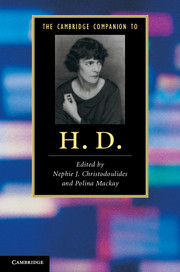Book contents
- Frontmatter
- Introduction
- PART I CONTEXTS AND ISSUES
- 1 ‘Uncanonically seated’: H.D. and literary canons
- 2 Facts and fictions
- 3 H.D. and the ‘little magazines’
- 4 H.D.'s modernism
- 5 H.D. and gender: queering the reading
- 6 Reading H.D.: influence and legacy
- PART II WORKS
- Further reading
- Index
- Cambridge Companions to…
5 - H.D. and gender: queering the reading
from PART I - CONTEXTS AND ISSUES
Published online by Cambridge University Press: 28 November 2011
- Frontmatter
- Introduction
- PART I CONTEXTS AND ISSUES
- 1 ‘Uncanonically seated’: H.D. and literary canons
- 2 Facts and fictions
- 3 H.D. and the ‘little magazines’
- 4 H.D.'s modernism
- 5 H.D. and gender: queering the reading
- 6 Reading H.D.: influence and legacy
- PART II WORKS
- Further reading
- Index
- Cambridge Companions to…
Summary
HERmione, H.D.'s early autobiographical novel, provides an excellent case study through which to explore the author's connections between gender, text and reader. In HER, H.D. exposes patriarchal textual gendering and, then, inserts texts alternative to the patriarchal ones. Mirrors, both literal and metaphorical, allow her women characters to read themselves and each other in spaces that produce lesbian eroticism, female subjectivity and a woman's writing. By framing through reflection, H.D. questions a patriarchal ‘normal’ subjectivity, subjectivity defined in terms of a unitary individualised self. Her reflecting, textualised women protagonists, paramount in her writing, illuminate, through the texts they create, a stirring gendered link between female subjectivity and creativity. For H.D., gender is a text to be read.
Patriarchal foundations
H.D.'s early fictional autobiographies – HERmione (1927), Paint it Today (1921) and Asphodel (1922) – portray (in that order, in sequential chronology) H.D.'s early years as a writer – when she first writes poetry, when Ezra Pound became her fiancé and mentor, when she meets her lovers Frances Gregg, Richard Aldington (her husband), Cecil Gray, then Winifred Ellerman (Bryher). Susan Stanford Friedman's and Rachel Blau DuPlessis' plot synopsis of these interlocking novels emphasises the gendered complications of their scripts: ‘This story moves from intense love of both man and woman, centers in the experiences of loss and betrayal engendered by heterosexual relationships in a patriarchal context, and ends in the celebration of a love for a woman and the birth of a girl child.’
- Type
- Chapter
- Information
- The Cambridge Companion to H. D. , pp. 63 - 76Publisher: Cambridge University PressPrint publication year: 2011

